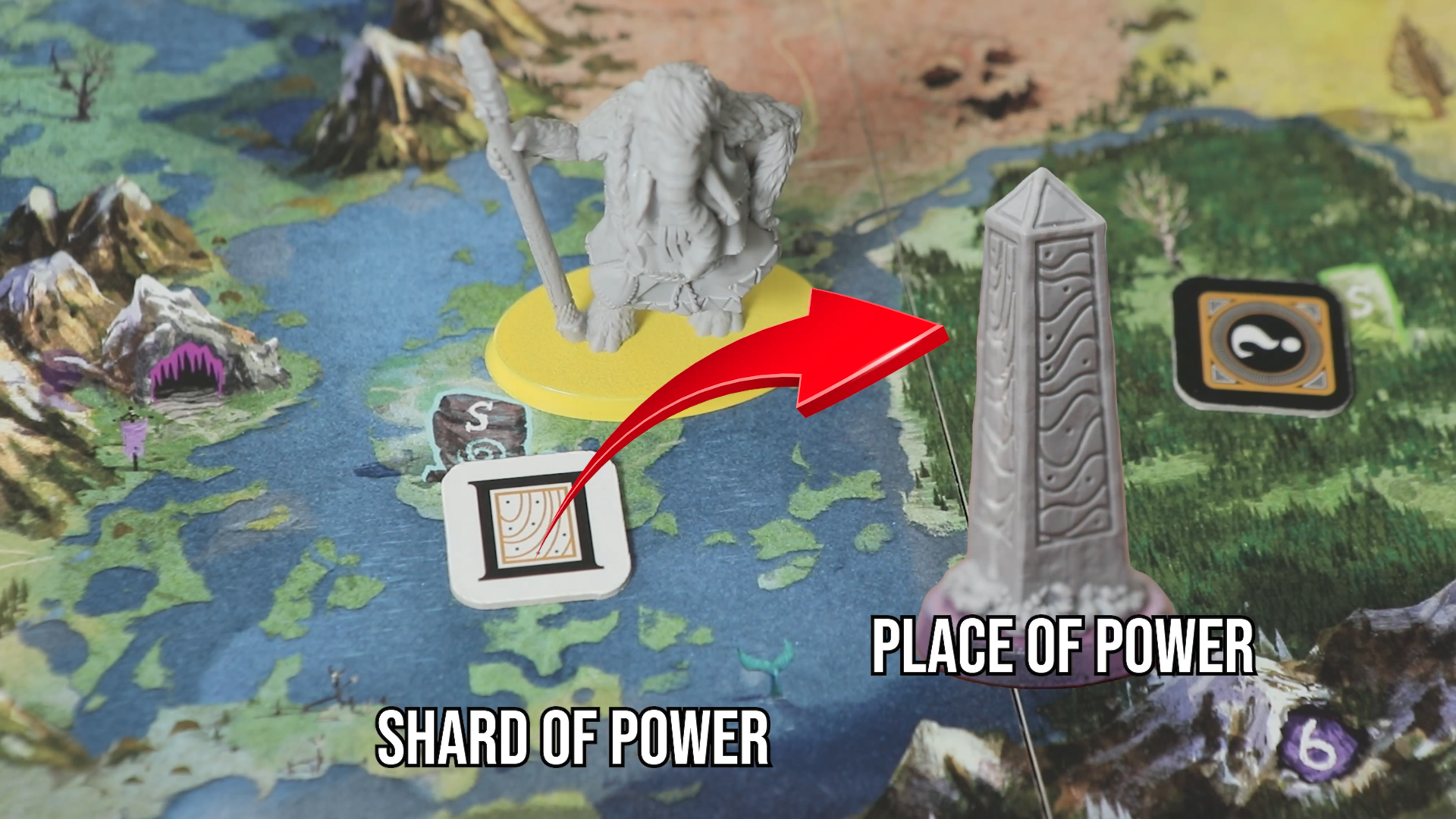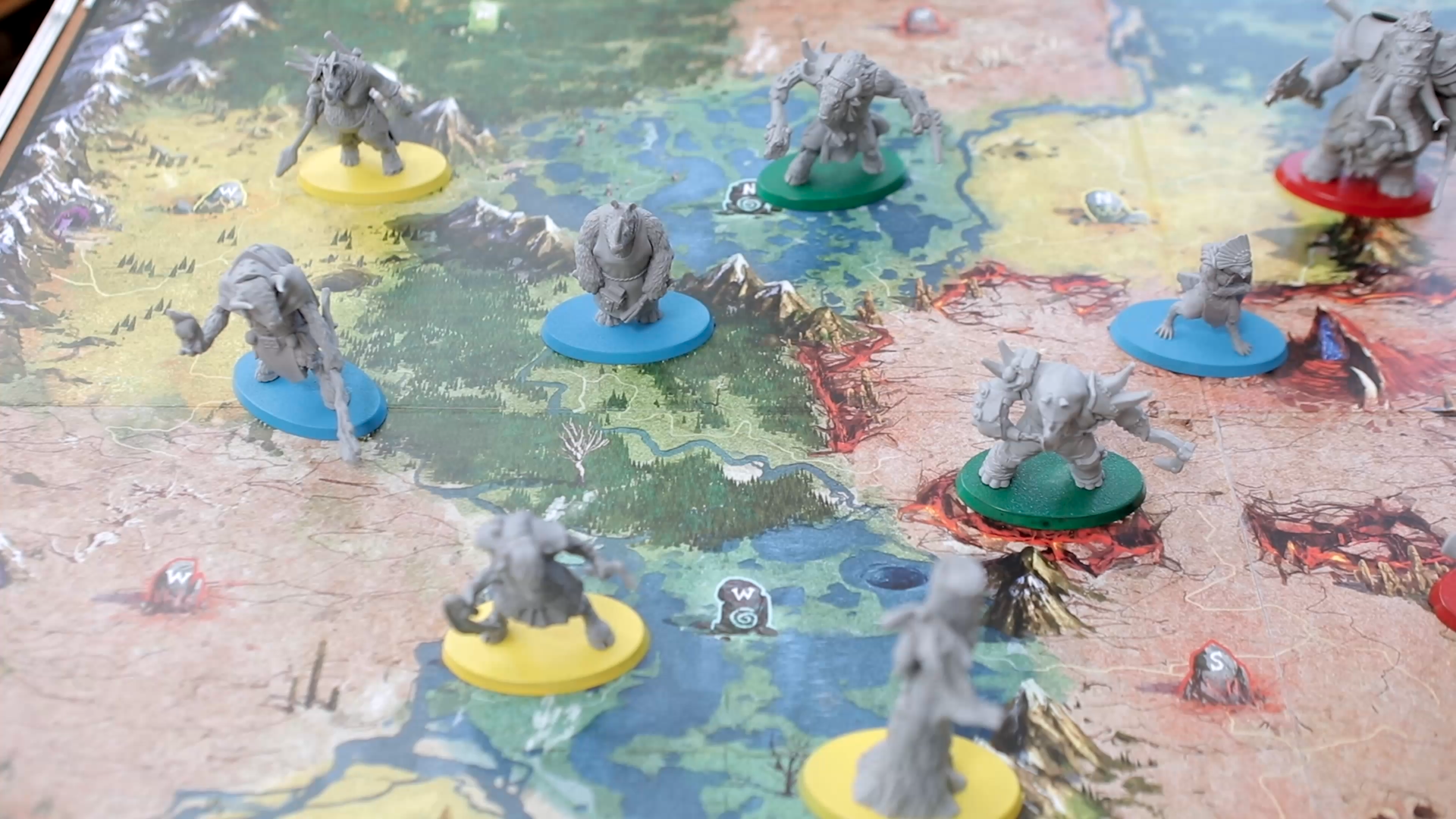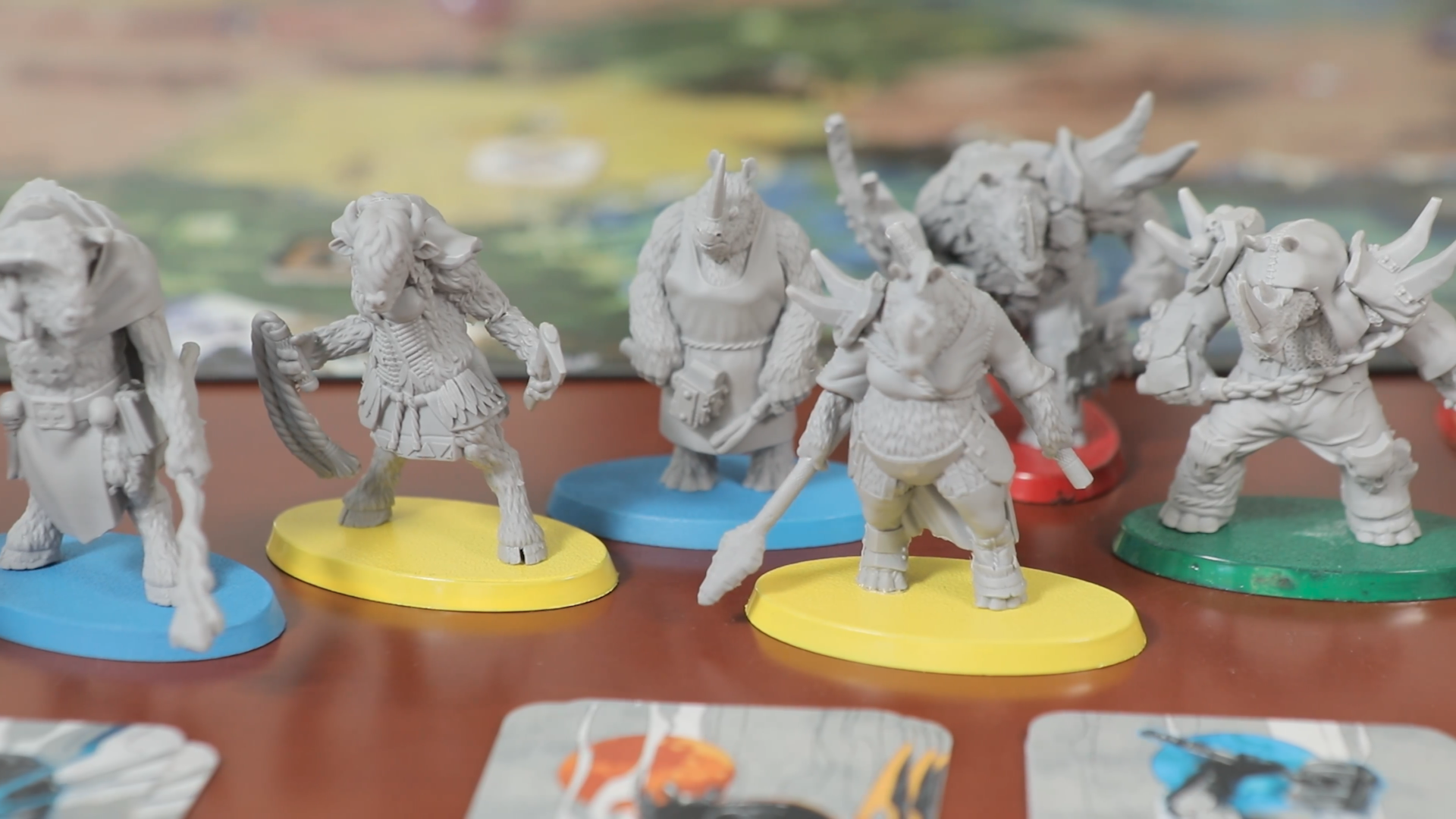Mammothodus Review
Matching 4 colors lets your gorgeous mammoth miniatures escape the humans.
Work cooperatively as ancient animal clans to escape a prehistoric world, where 4 colors dictate practically every aspect of the game, from deckbuilding, bad guy human movement, and the 4 actions. For 1-4 players, in 1.5 to 2.5 hours. Prototype featured.
Video published September 27th, 2022

Gorgeous, unique minis for every Ancient Clan.

Play 1 of 4 colors, managing your Clan's population and deck.

Explore the shards of power, and cooperate to transport them to the correct locations!
This is a sponsored post. Prototype featured.
Overview & How to Play
Mammothodus is all about awesome miniatures, and even more awesome card play.
We’re all controlling a clan of Ancients, trying to escape the world by building 4 “Pillars of Power” on the map before the humans kill us all. To do so, we need to discover and ferry “Shards of Power” to specific locations on the map, depending on what specific Ancient clues tell us, and then build a pillar using those shards.
Every turn, us Ancients have one action with our 4 card hands. To play cards, you pick your minis on the map, then play cards on them, then those minis perform that color. The outcome has to be all one type, BUT players can region-match, by playing a color that matches your mini’s location color, so then now that color can be any color you want. As such, players can play 2 green cards, and then 1 blue card that becomes a green card. So, the outcome there would be 3 green, which would be 3 movement for their minis.
Other than that green move, players can play red to attack humans, yellow to increase their population/health, and blue to deckbuild or build a Pillar of Power. Once finished with a turn, players draw back up to 4 cards from their individual decks.
After each player turn, humans also take their turn, where a single card from the top of the deck will get flipped, activating a certain type of color on the map. Every single human mini on those colors will attack us if we’re on those spaces, or move closer towards us. If humans don’t move from this, more spawn on the map.
Us players can lose from taking too much damage, having too many humans on the map, running out of time, etc. etc. But really, all you need to know here is that each player will take one action by playing one color of card(s) outcomes from hand, then the bad guy humans go, and then another player goes. Keep doing this until you all win or lose the game!
Pros
This is classified as a minis game, and man are the miniatures here no slouch. For the Bison, Rhinos, Mammoths, and Panthers, they are really fantastic, often feeling quite chunky in the hand and having engaging action poses. The 12 human miniatures are also super prehistoric-appropriate looking, and their 3 spirits they can create are nice and chunky to match our Ancient clan minis on the map. Oh, and that map is beautiful, filled with bright colors that is pleasing to color match with.
What’s possibly even prettier than the minis is the cards. You know how this game is all about the colors? Colors look fantastic on the cards, where each clan has their own cards with figures posed differently. Extra bonus that these posing figures, like a bison with a staff and a fireball in his right hoof, can often exactly match certain colored cards.
Let’s get to the gameplay of the 4 core actions, which mix together with the 4 different cards for impressive streamlined card play. Matching cards to the location your miniatures are at, to be any color you want, shoots up the possibilities of your hands. When you account for having multiple minis, and being able to play any numbers of cards as long as it results in one color, the possibilities are impressive. Plus, you have to factor in that your deck is only 12 cards, 3 of each color of card, and so once you play a color, your deck will have less copies of that color for a while.
There’s another another type of color matching, where if you match the cards you play with your specific miniature color, you get another bonus! You can play a red on a red miniature for more attacking dice. Or a green on a green miniature to move more.
And this game is a coop, so you can help allies by boosting their actions on their turns, where if they play a card, you can the same color, as long as you’re next to them! This makes you question positioning to be around them, but help them too much and your own hand will suck for your turn.
Mammothodus also boasts satisfying deckbuilding, with ways to get extra actions on your turn, get cards that are wilds, and also a way to draw 3 cards! Plus, when deckbuilding, these cards go immediately in your hand, letting you set up your next turn.
This lets us center on the “Generation Change” mechanic of the game more, where if you deck out, your clan undergoes a checkup: you must add/remove miniatures on the board according to your current population, and acquire useless curse cards in your deck if you didn’t play blue cards to prevent that degradation (yes deckbuilding also helps you prevent yourself from getting curses). The Generation Change is mad fun, because it makes the speed in which you go through your deck, which is the speed in which you play cards… which is doing anything in this game, vary based off this checkup. Maybe you play fast to speed through your deck and then eventually add another miniature to the board. Or you play slow to buy yourself time before you get permanent curse cards.
The cooperation in Mammothodus is also very noteworthy, since your team MUST have a plan to ferry the shards of power to win the game. Mammothodus is a hard game with limited time, so there is no way results will just happen, your team must be helping each other out and discussing how to move your animals around the map. You will find yourself constantly questioning how to deal with the ever increasing human populations too, which keep chasing your figures around the map, and continue to accumulate until killed. Your group will be concerned with killing humans, deciding where to move them, and going for the main objective.
Finally, Mammothodus’ progression is good in that it just keeps ratcheting up the tension. The humans continue to spawn, with new spawn points for them appearing randomly. Then the prerequisites to build Places of Power slowly get revealed to make your unattained Pillars even harder to build. Speaking of building pillars, you also want to watch where you build those, because the humans love to go there and create Spirits, which are super strong entities that take multiple hits to kill and teleport around the map to attack you.
But hey, its here we remind you that Mammothodus still has deckbuilding, so you can have stronger turns of playing multiple actions, drawing 3 cards, or cards that are worth 2 value instead of 1, and those feel great.
Cons
The copy of Mammothodus we reviewed was a preproduction prototype, and so was heavily mired by stuff we expect to be changed. For example, the rulebook had multiple translation and formatting issues, resulting in multiple mechanics that were very confusing to learn. This got piled onto the game’s lack of player aids, which would have definitely made Generation Change easier to understand.
Then, there’s definitely some concerns about replayability, since the ‘randomization’ for building Pillars of Power actually isn’t all that random once you figure it out. This could have been improved through the game’s 2 variants: an asymmetry one, and a hardcore variant. The asymmetry has players placing traps on the board by discarding cards as a non-action, which is a great idea, but is not polished at all. It has wording that continues to be confusing, and powers are not balanced at all, one of which called “Bait” that lets players displace multiple human regions, which massively disrupts their movement.
The hardcore variant is good fun in theory, which basically ramps up the game’s difficulty every time the “human” deck of cards runs out, by giving them a permanent ability, like letting them move THEN attack on one activation, making them harder to hit, etc. etc. While we haven’t tested it, we suspect that good luck plays too much of a factor in winning Mammothodus on this hardcore mode. So then you can only really use the hardcore variant with the asymmetry, but the asymmetry needs fixing, so the variants are all in a weird limbo right now.
And you know how we kept praising how good the minis look? Well, the problem is, is that they’re all grey, so they can be difficult to tell apart, where the color on their bases is used to differentiate their type, not what clan they are. This could be solved through your painting, but we would have preferred the bases to at least have some type of symbol, like a Mammoth tusk for the Mammoth clan figures.
There’s admittedly some nitpicks centered around the cooperative nature of Mammothodus, where it is possible for players to just tell everyone else what to do (i.e. quarterback), since there is complete open information. Granted, this isn’t as bad as Pandemic’s quarterbacking, since Mammothodus has players operating their own decks, and multiple miniatures on the board.
The cooperation can pad out the time length too, making Mammothodus run around 1.5-2 hours with a group, instead of the 1-1.5 hours as it says on the box. This is because you’re gonna want to cooperate a lot, so hey maybe this isn’t a bad thing. If you’re playing the solo mode, you could easily finish the game under an hour. Warning on the solo mode though: it is literally just playing 2 clans, or 2 decks of cards + sets of miniatures, there is no “true” solo mode provided.
Final Thoughts
Mammothodus generally has great gameplay and presentation, that is currently really driven down by jank. It boasts really clever streamlined card play of literally just 4 colors, all while teammates have to account for exploration, deckbuilding, combat rolling, different types of miniatures, enemy spirits, population to manage… the list goes on in a game with no weird cards or phases. Mammothodus is hard to win, forcing careful cooperation, where the game frequently slows down as players count their remaining cards in deck, what human colors can activate, and plan where to ferry shards.
Also, luck can play a pretty significant part, with 3 of the same human color triggering back to back, or just always rolling like garbage, especially on the re-rolls where you need to lose population to initiate that. Or spirits getting insanely high rolls to do 3 damage constantly. Yeah, dice-roller haters beware, if you get really behind on missing a lot of attacks in this game, its that hard that you probably want to restart.
We do think there was some missed opportunities with having asymmetry strictly tied to the Ancient Clans (e.g. the Rhinos can charge to attack, Mammoths are better at soaking up damage), but we’re not faulting the game’s score for that. Oh, and the wintery, bloody box cover does currently look a little out of place with the super colorful aesthetic the game has.
The mechanics don’t really change too much with player count either, where additional players just take up extra clans but the human deck flipping and setup function the same. But even with 4 players, you can play cards on anyone’s turn, so there isn’t too much downtime here. 3-4 players is the sweet spot here.





















